Fly fishers tend to rely on perception. And that perception often becomes our reality. For many Northern Hemisphere anglers, particularly those who fish the high-elevation rivers and streams of the Rocky Mountain West, we spend the months of May and June dredging deep runs in cloudy water hoping to pull a big, belligerent trout off the bottom as we power through heavy, turbid spring flows. The folks out east may get to enjoy springtime dry fly fishing, but those of us who live where towering snow-capped peaks predominate the landscape, spring is runoff season.
So that’s our perception. Early season trout must be fished deep and we just need to adapt to heavy, dirty water in order to get at them.
Last November, when I visited Chilean Patagonia — whose geography and climate is unquestionably more akin to that of the northern Rockies than it is to the low-lying Appalachians in the east — I did some quick math. I noted that December, with its solstice, is the equivalent of a North American June. Therefore, in the land of opposites, I deduced that November in Chile would look a lot like May here in the western U.S.
I loaded my fly box with bead-head nymphs, weighted San Juan Worms and heavy streamers, figuring that I’d be dredging for the region’s giant browns and rainbows and taking solace in the fact that, as I performed my least-favorite fly fishing discipline (nymphing), I’d at least get to see the Andes and the coastal mountains around Coyhaique and get a feel for the area. Perhaps, another time, I could return during high summer and devote a trip to dry-fly angling.
Perception.
More Like This
Oh, how I love to be proven wrong. And I have Eduardo Guarda to thank for that. The owner of three destination fishing lodges in Chile, Eduardo was quick to direct me to the fly-tying vise at his Magic Waters Lodge, which is idyllically nestled on the shores of a very fishy lake roughly 30 miles outside of the city of Coyhaique.
“You need dry flies,” he told me. “Big dry flies. Chernobyls. Big hoppers. Ants. Mayflies.”
Huh? In the spring? As the snow runs off the Andes?
Whatever, dude. I tied a few half-hearted foam beetles and some hoppers, all the while doubting the guy who runs the fishing operation. Because my perception, of course, was my reality.
And then we went fishing.
As Eduardo led us on a short jaunt across a pasture to the upper Rio Munoz — a modestly-sized spring creek that meanders through high-meadow ranchland, offering a seemingly endless conveyor belt of cutbanks and bend pools — it became obvious that my perception wasn’t worth a damn. As we approached the water, the first thing I noticed was a hearty big-fish rise ring right along the bank. At Eduardo’s insistence, I tied on a size 6 Fat Albert, and cast the fly across the modestly murky spring creek and let it plop onto the water about five feet from where I saw the rise.
And, like clockwork, an 18-inch brown laid waste to the fly.
“Just like that?” I asked, getting the fish on the reel.
“Just like that,” Eduardo said. I ran out of dry flies shortly after lunch, and spent the afternoon plying Eduardo for more. The next day, on Panatalli Spring Creek — where lushly vegetated, verdant banks and deep, slow, weedbed-lined pools offered an entirely different fishing experience from that on the Munoz — mayflies were on the menu. Panatalli’s rainbows and browns rose cautiously, but readily, to various high-floating Catskill, parachute, and spinner patterns from the moment we stepped on the creek until the dinner bell called us off the river and back to the lodge.

The next few evenings, while the other Magic Waters Lodge guests enjoyed dessert in the dining room or pisco sours around the funkiest pool table in Patagonia, I hunched over the vise and tied at least a dozen more Fatties and a handful of size 10 Adams.
And I know what you’re thinking. Our first destinations were spring creeks, the least-impacted watersheds when it comes to runoff, right? Fair enough. But truth be told, no matter where we fished over the course of the next two weeks, whether it was a freestone stream tumbling off the Andes, the Rio Paloma, an emerald-green rainforest waterpark, or the backcountry stunner, the Rio Mogote, our guides instructed us to start with a dry fly. And, generally speaking, a big dry fly.
Later in the trip, on the Rio Blanco based out of Eduardo’s River of Dreams basecamp, the fly of choice was an honest-to-God Morish Mouse. We even launched Eduardo’s sturdy cata-rafts on a couple of area lakes, and, once again, we hunted rising fish and threw ungodly big dry flies at giant trout that seemed to be constantly looking up.
So much for perception.
Honestly, it got downright silly on the Mogote, which, despite its course through the mountains in the Patagonian spring, flowed perfectly clear. After a short horseback ride into the river’s more remote reaches, my guide for the day, Ives, tied a size 8 Stimulator to my tippet and slowly walked the rocky river bank with me. Young Ives has the eyes of a flats guide, and he spotted two sizable trout holding on the edge of some fast water, just below a tailout. He pointed at the fish.
“There,” he said. “Cast.”
More perception came into play. Fly fishing is about the only thing I do where I take the time to be truly calculating. I took one look at where the trout were holding and immediately started to walk upstream a bit, knowing that I’d need a good reach cast, a big mend, the right angle and a hell of a lot of luck to get a solid drift over those fish.
“What are you doing?” Ives asked. I launched into an animated explanation about the right line, the perfect angle and a short mathematical treatise that came about as close to trigonometry as I’ve been since my freshman year in college, but Ives wouldn’t have it. He shook his head and held up his hand.
“Just cast,” he said. “Don’t worry about the drift.”
This kid has a lot to learn, I thought. I’ll show him.

As instructed, I grumpily threw the floatant-laden Stimulator into the current above the trout lying in wait. The fly landed perfectly and it drifted on exactly the right line … for about a half a second. Then, as my theory proved true, even with the reach cast and a desperate mend, the Mogote grabbed my leader and started to pull the fly along the surface with enough speed to create a frothy wake.
I looked at Ives as if to say, See? I told you so, you little shit, only to notice that he was watching my fly skate over the trout. I looked back at the river and watched in disbelief as the first big brown left its lie in the soft water and gave chase to the fly as my leader unceremoniously dragged it downstream.
“What the …” I uttered, watching the scenario unfold in front of my eyes. Ives just smiled. I was so surprised by the situation that I missed the fish as it desperately tried to get at the Stimulator before it entered some choppy water and disappeared altogether.
The fly, well out of reach of the fish, skied across the river and stretched my fly line out below me. I watched as the brown – maybe 17 inches of river-conditioned salmonid – moved right back to its lie ahead of the second trout that was roughly the same size. Could it be? Could I get another shot at this fish? Or, perish the thought, the other fish?
“Cast again,” Ives said.
I lifted the rod and immediately felt resistance. Thinking I’d snagged up on a rock or a piece of drowned wood, I turned downstream and watched as my leader and fly line started to move off the bank and into the current. I was hooked up to another fish that apparently couldn’t resist the skated Stimmy. A few minutes later, Ives posed for a photo with a nice Rio Mogote brown trout, the happy accident that occurred despite my close-minded approach to spring angling in Chile.
Once again, my perception had failed me. And it was a good lesson. From then on, for about the next two weeks, I put my perception on the shelf. Spring in Patagonia isn’t necessarily like spring in Idaho. And a skated Stimulator in a gin-clear, backcountry river can, indeed, pull a chunky brown out of its comfortable resting place.
Eduardo was right. I needed more dry flies. I put the lodge’s vise through its paces on that trip. If you’re smart, and if you’re lucky enough to fly fish Chilean Patagonia anytime soon, you’ll go to school on my faulty perception. Tie flies at home. Spend your time at the lodge enjoying cocktails and playing pool.
Spring in Patagonia is for dry flies. Don’t believe me? Well, I can’t blame you. You just might have to see it for yourself.





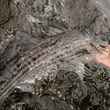
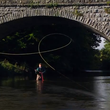





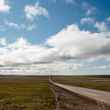




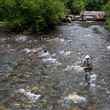
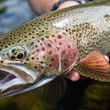



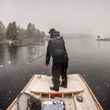
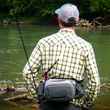



![Instructors John Juracek [left] and Brant Oswald [right] from The School of Trout (photo: Tim Romano). school of trout instructors john juracek brant oswald](https://www.hatchmag.com/sites/default/files/styles/gallery_thumbnail/public/field/image/romano-0024.jpg?itok=X_had7Jf)
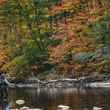

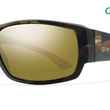

Comments